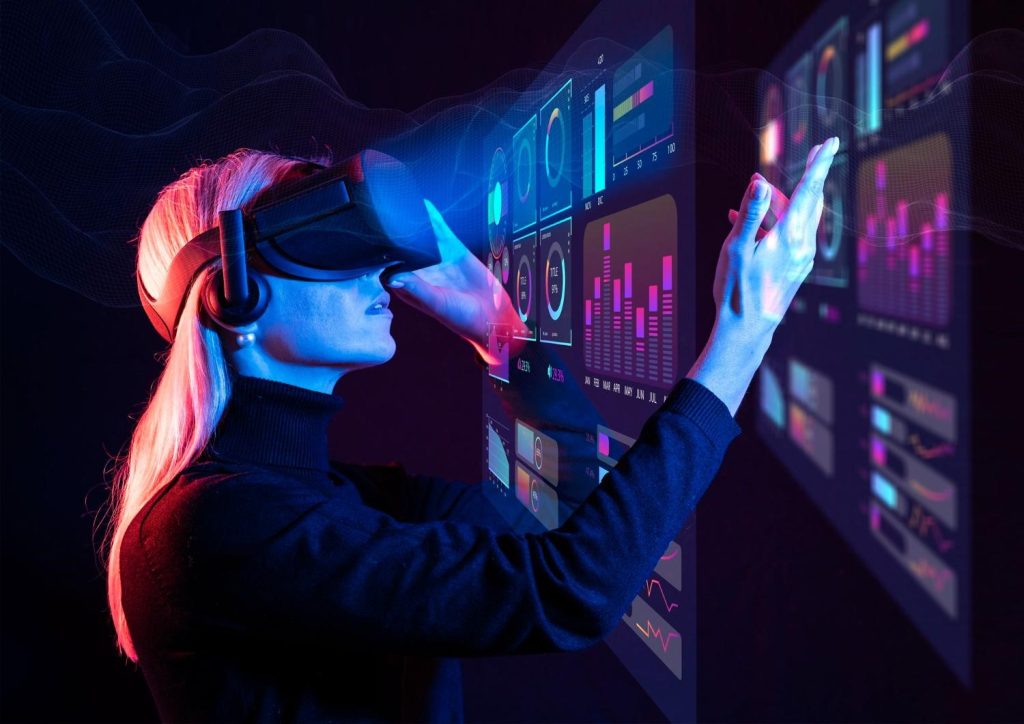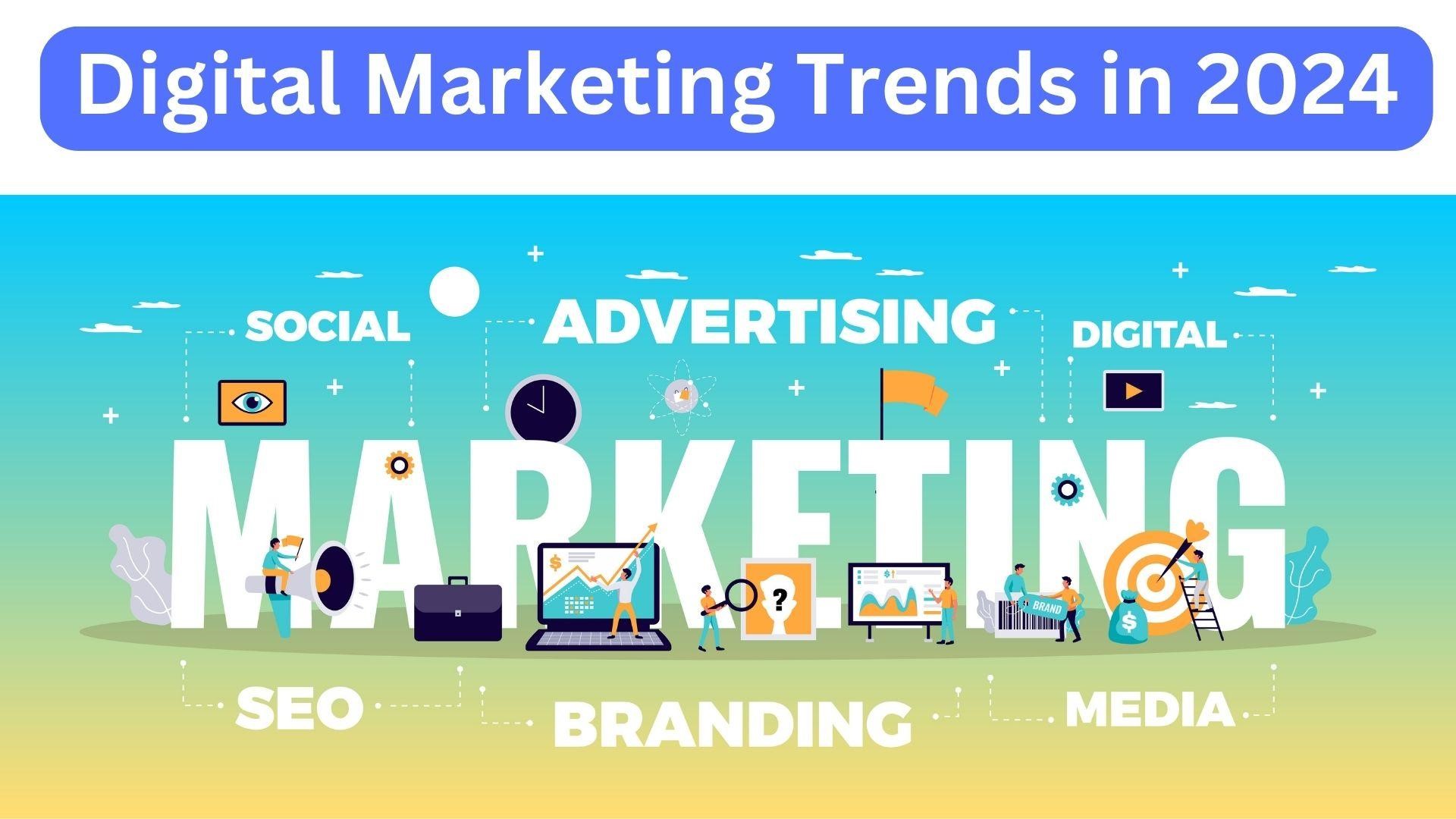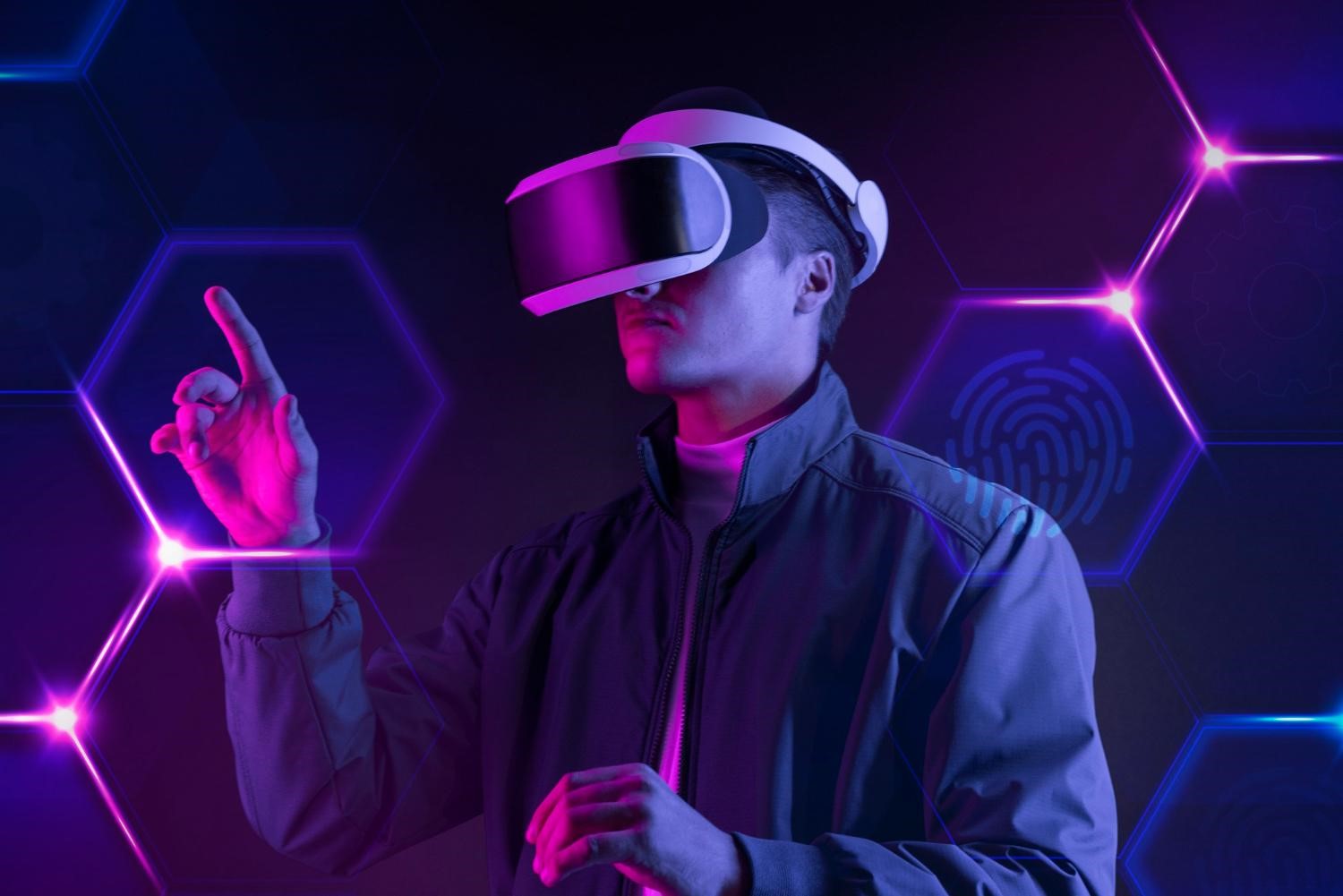Top Digital Marketing trends in 2024
Introduction:
In the rapidly changing field of digital marketing, staying ahead of the competition is critical to success. As we enter 2024, the environment is fast changing due to technological developments, altering consumer behaviours, and novel methods. In the realm of digital marketing trends, programmatic marketing automated ad buying with precision, complementing broader strategies in digital marketing for dynamic and data-driven campaigns. Still, some people have doubts that digital marketing is growing? Without a doubt, digital marketing is experiencing exponential growth and evolving as the cornerstone of modern business success. In this blog, we explore deep into the top and latest digital marketing trends that are expected to define the year 2024.
1. Artificial Intelligence (AI) in Digital Marketing:

Automation of Repetitive processes:
In digital marketing, artificial intelligence (AI) is essential for automating routine and time-consuming processes. From data analysis and reporting to social media posting schedules, AI-powered automation enables marketers to optimize their operations while saving time and money.
Personalised content Delivery:
AI recommends content based on user behavior, preferences, and past data. AI can analyze massive quantities of data using algorithms and machine learning models to provide highly targeted and relevant information to individual users, hence improving the overall user experience.
Chatbots for Customer Interaction:
AI-powered chatbots are transforming interactions with customers. These bots employ natural language processing to interpret and answer user inquiries, giving immediate assistance and information. Chatbots help to increase customer service, engagement, and lead generation.
Predictive Insights for Decision-Making:
AI analyzes historical data to detect patterns and trends. Marketers may utilize predictive models to estimate consumer behavior, optimize marketing tactics, and make data-driven choices. This proactive strategy improves both campaign effectiveness and budget allocation.
Image and speech recognition:
AI-powered picture and speech recognition technologies improve the visual and auditory parts of digital marketing. Visual material may be analyzed to find brand references or user-generated content, while speech recognition allows for voice search optimisation and the creation of voice-activated marketing campaigns.
Dynamic Pricing Strategies:
AI facilitates dynamic pricing by analyzing market conditions, competitor pricing, and customer behavior. For example, E-commerce platforms can dynamically change prices based on demand, levels of stock, and other variables, optimizing revenue and competitiveness.
Fraud Detection and Security:
AI helps detect fraudulent activity in digital marketing, such as click fraud and false accounts. Machine learning algorithms can detect and prevent fraudulent behavior, guaranteeing a safe and trustworthy online environment.
2. Machine Learning (ML) in Digital Marketing:
Client Segmentation and Targeting:
Machine learning algorithms use big datasets to discover unique client categories based on numerous characteristics. This enables marketers to customise their campaigns for specific audience segments, resulting in more focused and successful marketing messaging.
Personalised Behavioural Analysis:
ML algorithms can analyse user behaviour across digital platforms, including websites and applications. Understanding how consumers engage with material allows marketers to personalise their services, promote items, and provide a more tailored user experience.
Predictive Lead Scoring:
ML models assist marketers in identifying leads with higher conversion rates. Machine learning algorithms provide lead scores after analysing past data on leads and customer conversions, allowing marketers to focus their efforts on the most promising prospects.
Content Optimization and A/B Testing:
ML algorithms can optimise content based on user interaction data. Machine learning improves A/B testing, which compares alternative versions of the same material. Algorithms can rapidly determine which versions resonate most with the audience, resulting in more successful content strategies.
Natural Language Processing (NLP):
This subset of machine learning is essential for comprehending and processing human language. It is used for sentiment analysis, chatbots, and language-based insights. NLP allows marketers to assess public opinion, reply to consumer inquiries, and extract useful insights from textual data.
Recommendation Engine:
Machine learning fuels recommendation engines, which propose products, services, or information based on user interests and behavior. Whether it’s recommending items on an e-commerce platform or articles on a news website, recommendation engines boost user engagement and conversion rates.
3. Integration of AI and ML in Digital Marketing:
While AI and ML have distinct applications, they often work synergistically in digital marketing. The integration of AI and ML allows for a comprehensive and dynamic approach to data analysis, customer engagement, and campaign optimization.
AI-Driven Predictive Analytics:
The combination of AI and ML in predictive analytics enhances the accuracy and depth of predictions. AI algorithms can identify trends, and ML models refine predictions based on evolving data, providing marketers with real-time insights for more informed decision-making.
Personalization at Scale:
The fusion of AI and ML enables personalization at scale. AI analyzes data to understand user behavior and preferences, while ML algorithms apply this knowledge to dynamically personalize content, emails, and recommendations for a large audience.
Chatbots with ML-Powered Conversations:
Chatbots benefit from both AI and ML capabilities. AI enables natural language understanding, and ML refines responses based on user interactions over time. This synergy results in chatbots that not only understand user queries but also improve their conversational abilities through machine learning.
Dynamic Content Optimization:
AI can analyze content performance, and ML models can optimize content dynamically. This integration ensures that digital marketing content is not only personalized but also continually refined based on user interactions and evolving trends.
Advanced Fraud Detection:
Combining AI and ML enhances fraud detection capabilities. AI algorithms can quickly identify patterns indicative of fraud, and ML models continually adapt to new tactics, ensuring a robust and proactive approach to fraud prevention in digital marketing.
Enhanced Customer Segmentation:
AI identifies broad customer segments, and ML refines these segments based on ongoing interactions and behaviors. This integration allows marketers to create highly targeted campaigns and adapt their segmentation strategies as customer preferences evolve.
4. Voice Search Optimization:

Voice search continues to gain prominence as smart speakers and voice-activated devices become ubiquitous. Optimizing digital content for voice search is now imperative for marketers aiming to capture the growing number of users relying on voice-activated assistants like Siri, Alexa, and Google Assistant.
The Impact of Smart Devices
With the increasing popularity of smart speakers and smartphones, voice search has become an integral part of users’ daily lives. People are now using voice commands not just for simple queries but also for complex searches, making it crucial for businesses to adapt their SEO strategies accordingly.
Natural Language Processing in SEO
Traditional SEO strategies are evolving to accommodate natural language queries. Long-tail keywords and conversational content are gaining importance as they align more closely with the way people speak. Marketers need to understand user intent and create content that answers specific questions, catering to the nuances of voice search.
Local Optimization for Voice
Voice search often has a strong local intent. Users frequently use voice commands to find nearby businesses or obtain location-specific information. Optimizing content for local search, including creating and updating Google My Business profiles, is essential for businesses looking to capitalize on the opportunities presented by voice search.
5. Video Marketing Dominance:
Video marketing continues to be a powerhouse in the digital realm, captivating audiences across platforms. From short-form videos on TikTok to long-form content on YouTube, video marketing remains a versatile and effective strategy for engaging users.
The Short-Form Video Explosion
Short-form videos, epitomized by platforms like TikTok and Instagram Reels, have witnessed an explosion in popularity. These bite-sized, visually appealing videos are capturing the attention of younger demographics and are an excellent vehicle for brand storytelling, product showcases, and entertainment.
The Proliferation of Live Streaming
Live streaming has become a dynamic tool for real-time engagement. Platforms like Facebook Live, Instagram Live, and Twitch provide opportunities for brands to connect with their audience in an authentic and interactive way. Live Q&A sessions, product launches, and behind-the-scenes content can foster a sense of community and loyalty.
Interactive and Shoppable Videos
Incorporating interactivity into videos is gaining traction. Shoppable videos, which allow viewers to make purchases right from the video, are blurring the barriers between entertainment and e-commerce. Interactive elements like polls, quizzes, and clickable links within videos enhance user engagement and create a seamless path to conversion.
6. Augmented Reality (AR) and Virtual Reality (VR):
The realms of Augmented Reality and Virtual Reality are expanding, offering immersive experiences that go beyond traditional marketing approaches. Brands are harnessing these technologies to create memorable and interactive experiences for their audiences.

AR for Interactive Product Experiences
Augmented Reality is transforming the way users interact with products. From virtual try-on experiences for fashion and beauty products to visualizing furniture in a real-world setting before purchase, AR enhances the customer journey. Brands are incorporating AR features into their mobile apps and websites to provide a more engaging and informative shopping experience.
VR for Virtual Shopping and Events
Virtual Reality is not limited to gaming; it’s becoming a valuable tool for virtual shopping experiences and events. With the integration of VR marketing, Virtual storefronts allow users to browse and purchase products in a virtual environment, while VR events provide an immersive alternative to in-person gatherings. This is particularly relevant in a world where remote and virtual experiences are increasingly prevalent.
Enhanced Brand Storytelling
AR and VR offer new dimensions for brand storytelling. Interactive narratives and virtual experiences allow brands to convey their messages in ways that resonate deeply with users. Whether it’s a virtual tour of a brand’s origin or an interactive story unfolding in augmented reality, these technologies enable brands to connect with audiences on a profound level.
7. Influencer Marketing Evolution:
Influencer marketing continues to be a potent strategy, but its dynamics are evolving. Authenticity and genuine connections are taking precedence over follower count, leading to the rise of micro and nano-influencers.
The Shift Toward Authenticity
Consumers are becoming increasingly discerning, seeking authenticity in the content they consume. Mega influencers with massive followings are losing some of their appeal as users crave more genuine and relatable content. Micro and nano-influencers, who often have more engaged and niche audiences, are gaining favour among brands.
Long-Term Partnerships with Influencers
Building lasting relationships with influencers is becoming a key trend. Instead of one-off collaborations, brands are looking for influencers who align with their values and can become long-term ambassadors. This approach fosters trust and consistency, as influencers become an integral part of the brand’s narrative.
Diversification of Influencer Platforms
While Instagram remains a prominent platform for influencer marketing, diversification is on the rise. Platforms like TikTok, YouTube, and even emerging channels are becoming viable options for influencer collaborations. Brands are adapting their strategies to align with the preferences of their target audiences across different platforms.
8. Personalization at Scale:
Personalization has been a buzzword in digital marketing, but in 2024, it’s evolving to a new level—personalization at scale. Marketers are leveraging data-driven insights to deliver highly personalized experiences to a broad audience.
Dynamic Content for Individualized Experiences
Dynamic content adapts to individual user characteristics, behavior, and preferences. Whether it’s personalized product recommendations, dynamically generated email content, or tailored website experiences, dynamic content ensures that each interaction feels customized. This not only improves user engagement, but it also raises conversion rates.
AI-Driven Personalization Strategies
Artificial Intelligence is playing a pivotal role in enabling personalization at scale. Machine learning algorithms analyze user data to predict preferences and behaviors, allowing marketers to deliver relevant content in real-time. Personalized chatbots, recommendation engines, and dynamic pricing are some examples of AI-driven personalization.
Hyper-Personalization in Email Marketing
Email marketing is undergoing a transformation with hyper-personalization. Beyond personalized subject lines and greetings, marketers are using AI to create highly individualized email content. This includes product recommendations based on past purchases, personalized offers, and content tailored to specific user segments.
9. Privacy and Data Security:
As concerns around privacy and data security intensify, marketers are navigating a landscape of stringent regulations and heightened consumer expectations. Building trust through transparent data practices and ethical use of customer information is paramount.
Adapting to Stricter Regulations
Regulations like GDPR (General Data Protection Regulation) and CCPA (California Consumer Privacy Act) have set stringent guidelines for the collection and use of personal data. Marketers need to ensure compliance with these regulations, obtain proper consents, and communicate clearly about how customer data is handled.
Zero-Party Data Collection
Zero-party data, voluntarily provided by users, is gaining importance. By directly asking customers for their preferences, interests, and consent, businesses can build a more transparent and mutually beneficial relationship. This approach ensures that users are actively participating in data sharing, leading to more accurate personalization.
Blockchain for Secure Data Management
Blockchain technology is emerging as a solution for secure and transparent data management. The decentralized nature of blockchain ensures that data is stored in a tamper-proof manner. Marketers are exploring blockchain for secure transactions, verifying the authenticity of customer data, and ensuring transparency in supply chains.
10. Social Commerce Integration:
Social media platforms are no longer just spaces for brand promotion; they are evolving into full-fledged ecommerce channels. The integration of social commerce features is simplifying the customer journey and providing seamless shopping experiences within social platforms.
Shoppable Posts and In-App Purchases
Shoppable posts on platforms like Instagram and Facebook allow users to make purchases directly within the app. In-app purchases streamline the buying process, reducing friction between product discovery and conversion. This integration is particularly effective for impulse purchases and trending products.
Integrated Checkout Processes
Social platforms are increasingly integrating checkout processes within the app. Users can add products to their cart, choose variants, and complete transactions without leaving the social media environment. This frictionless experience is contributing to the growth of social commerce and reshaping online shopping habits.
Social Media as Discovery Platforms
Social media platforms are becoming the primary discovery channels for products and brands. Users often come across new products through influencer recommendations, sponsored content, or user-generated posts. As a result, brands need to optimize their social media presence and leverage social commerce features to capitalize on these discovery moments.
11. Sustainable and Purpose-Driven Marketing:
Consumers are more aware of the environmental and social implications of their shopping decisions. Brands that align with sustainable and purpose-driven values are gaining favor, and marketing campaigns centered around these themes are resonating with conscious consumers.
The Rise of Eco-Friendly Initiatives
Sustainability is not just a buzzword; it’s a driving force in consumer preferences. Brands are adopting eco-friendly practices in product manufacturing, packaging, and distribution. Marketing campaigns that highlight these initiatives are not only attracting environmentally conscious consumers but also contributing to a positive brand image.
Social Responsibility as a Brand Pillar
Consumers are increasingly expecting brands to take a stand on social issues. Marketing campaigns that advocate for social causes, promote inclusivity, and support community initiatives are gaining traction. Brands are recognizing the importance of aligning with values that resonate with their target audience.
Transparent Communication about Ethical Practices
Transparency is key to building trust. Brands are communicating openly about their ethical practices, from supply chain transparency to fair labor practices. Marketing messages highlight these ethical considerations, assuring consumers that their purchasing decisions contribute to a greater good.
Interactive Content and Gamification:
Effective digital marketing requires engaging content. Gamification and interactive content are gaining popularity as effective strategies for capturing audiences, encouraging engagement, and creating memorable brand encounters.
Quizzes and polls for audience engagement
Quizzes and polls are powerful ways to engage people and collect their thoughts. Brands are using interactive components in social media, websites, and even email marketing. Quizzes can be informative, amusing, or product-related, opening up a two-way communication channel with the audience.
Gamification for User Interaction
Gamification involves incorporating game-like elements into non-game contexts. From loyalty programs and rewards systems to interactive challenges, gamification encourages user participation. This approach is particularly effective in retaining audience interest and fostering a sense of competition or achievement.
12. Chatbots and Conversational Marketing:
As consumers seek instant and personalized interactions, chatbots and conversational marketing are becoming integral components of digital strategies. These tools provide real-time engagement and support, enhancing the overall customer experience.

AI-Powered Chatbots for Instant Support
Chatbots, powered by AI, offer instant support and information. They can handle customer queries, provide product recommendations, and guide users through the purchase process. The sophistication of chatbots is increasing, with natural language processing enabling more fluid and human-like conversations.
Conversational Marketing Platforms
Conversational marketing platforms facilitate real-time interactions between brands and customers. Whether through messaging apps, live chat on websites, or integrated chat features in mobile apps, conversational marketing creates a direct and immediate communication channel. This personalised approach contributes to customer satisfaction and loyalty.
Personalization through Conversations
Conversational marketing allows for highly personalised interactions. By understanding user preferences and behaviours, brands can tailor their messaging, offers, and product recommendations in real-time. This level of personalization contributes to a seamless and enjoyable customer journey.
13. 5G Technology Impact:
The rollout of 5G technology is transforming digital experiences by providing faster internet speeds, lower latency, and greater connectivity. This technology is influencing various aspects of digital marketing, opening new possibilities, and enhancing existing strategies.
Enhanced Mobile Experiences
5G technology significantly improves mobile internet speeds, leading to enhanced mobile experiences. This is particularly relevant for video streaming, AR, and VR applications, which benefit from seamless and high-quality content delivery. Marketers need to optimise their content for these faster networks to provide a smooth user experience.
Opportunities for Immersive Technologies
The low latency offered by 5G opens up new possibilities for immersive technologies like AR and VR. Real-time interactions, enhanced graphics, and seamless experiences are now more achievable, allowing marketers to create more engaging and realistic virtual experiences for their audiences.
Impact on the Internet of Things (IoT)
The Internet of Things (IoT) relies on robust connectivity, and 5G provides the infrastructure needed for widespread IoT adoption. Marketers can leverage IoT data for more targeted campaigns, personalised experiences, and real-time insights into consumer behaviours.
14. User-Generated Content (UGC)
In the dynamic realm of digital marketing, the spotlight for 2024 is firmly on User-Generated Content (UGC), a transformative force reshaping brand-consumer interactions. Here’s an in-depth exploration of how UGC is set to redefine the digital marketing landscape in the coming year.
Authenticity Reigns Supreme:
In 2024, consumers will seek authenticity more than ever. User-generated content provides a genuine and unfiltered perspective, allowing brands to connect on a deeper level. As trust becomes a cornerstone, UGC emerges as a powerful tool for building credibility and fostering genuine relationships.
Community-Driven Engagement:
Digital marketing is evolving into a community-driven space, and UGC is at the forefront of this shift. Brands are not just creating content for consumers; they are inviting consumers to actively participate in the brand narrative. Through challenges, campaigns, and interactive content, UGC becomes a catalyst for community engagement and brand loyalty.
Amplifying Social Proof:
User-generated content serves as a living testimonial for brands. In 2024, leveraging UGC as social proof will become essential. Whether it’s product reviews, customer testimonials, or real-life product demonstrations, UGC provides the social validation that influences purchasing decisions, contributing to increased brand credibility.
Diversification of Platforms:
As social media platforms evolve, so does the landscape for UGC. In 2024, we anticipate the diversification of UGC across a multitude of platforms, from traditional social media channels to emerging platforms and even brand-owned spaces. Brands will need to adapt their strategies to harness UGC effectively across these diverse landscapes.
Influencer-UGC Synergy:
The collaboration between influencers and UGC will witness a surge in 2024. Brands will actively encourage influencers to engage with and generate user content, creating a seamless blend of professional and authentic perspectives. This synergy enhances both influencer marketing strategies and the organic reach of UGC.
Integration with E-Commerce:
In the evolving digital marketing trends, UGC is not confined to awareness and engagement; it plays a pivotal role in driving conversions. Brands will increasingly integrate UGC into their e-commerce strategies, allowing customers to visualize products in real-world scenarios, making the purchasing journey more interactive and personalized.
Navigating Privacy and Consent:
With increased emphasis on data privacy, navigating the legal and ethical aspects of UGC becomes crucial. Brands must ensure transparent communication and seek explicit consent when curating and utilizing user-generated content, respecting the boundaries of user privacy.
15. Live streaming
In Digital Marketing, live streaming emerges as a dynamic force, reshaping the way brands connect with their audiences. The evolution and anticipated impact of live streaming in the digital marketing landscape are as follows
Rise of Interactive Experiences:
In 2024, live streaming transcends passive content consumption. Brands leverage live streaming to create interactive experiences, engaging audiences in real-time conversations, Q&A sessions, and immersive behind-the-scenes glimpses. This interactivity fosters a sense of community and connectivity.
Authenticity and Transparency:
Live streaming becomes a cornerstone for brands aiming to convey authenticity and transparency. In an era where consumers value genuine connections, live streams offer an unfiltered and real-time glimpse into a brand’s culture, processes, and people, establishing trust and credibility.
Integration with E-Commerce:
Live streaming seamlessly integrates with e-commerce strategies. Brands leverage live commerce, where products are showcased, demonstrated, and sold in real time. Viewers can make purchases directly within the live stream, transforming the traditional online shopping experience into an engaging and interactive event.
Personalized Engagement:
Live streaming in 2024 is not just about broadcasting; it’s about personalized engagement. Brands tailor live content to specific audience segments, addressing their unique interests and preferences. This customization enhances viewer experience and maximizes the impact of live streaming campaigns.
Multi-Platform Broadcasting:
While platforms like YouTube, Facebook, and Instagram continue to be live streaming hubs, 2024 sees an expansion to new and emerging platforms. Brands diversify their live streaming presence to reach audiences where they are, exploring platforms that align with their target demographic.
Influencer Collaborations:
Live streaming becomes a key avenue for influencer collaborations. Brands join forces with influencers to host live events, product launches, and interactive sessions. This synergy leverages the influencer’s audience for increased reach and authenticity in a live setting.
Augmented Reality (AR) Enhancements:
Incorporating augmented reality elements into live streaming experiences will become a trend in 2024. Brands enhance their live content with AR overlays, filters, and effects, creating visually captivating and innovative broadcasts that captivate audiences and set the stage for immersive brand storytelling.
Analytics and Measurement Tools:
As live streaming takes on a more prominent role in marketing strategies, robust analytics and measurement tools come into play. Brands leverage data insights to track viewer engagement, measure conversion rates, and refine their live streaming approach for maximum impact.
Live streaming is not just a fleeting trend but a transformative force in digital marketing, offering brands an unparalleled opportunity to connect, engage, and convert in real time. As technology continues to advance, brands that harness the power of live streaming in 2024 will be at the forefront of the ever-evolving digital landscape.
In Conclusion
As we navigate the dynamic landscape of digital marketing in 2024, the key takeaway is clear: adaptability is paramount. The convergence of emerging technologies, evolving consumer preferences, and the ever-changing digital ecosystem necessitate a proactive approach.
From the integration of artificial intelligence and machine learning to the immersive experiences offered by augmented and virtual reality, the digital marketing arena is marked by innovation. Voice search optimization, video marketing dominance, and the evolution of influencer marketing showcase the dynamic nature of consumer interactions.
Personalization at scale, social commerce integration, and a focus on sustainability and purpose-driven marketing underscore the importance of creating meaningful connections with the audience. As privacy and data security become non-negotiable considerations, transparent communication and ethical practices are crucial for building trust.
Interactive content, gamification, and the strategic use of chatbots reflect the industry’s commitment to providing engaging and personalised experiences. The advent of 5G technology further amplifies the potential for immersive technologies, creating new avenues for marketers to explore.
In this ever-evolving landscape, successful marketers will be those who embrace change, leverage technology responsibly, and prioritise authentic connections with their audience. As we embark on the journey through 2024, the digital marketing landscape promises exciting opportunities for those ready to innovate and meet the evolving needs of their audience.
By staying ahead of these digital marketing trends, businesses, with the assistance of ProPlus Logics solutions Company, can adapt their strategies to meet the evolving needs and expectations of their target audience.
 " alt="">
" alt="">








